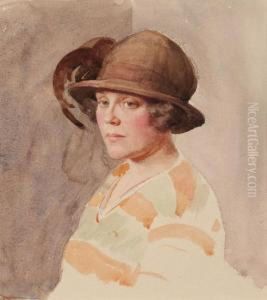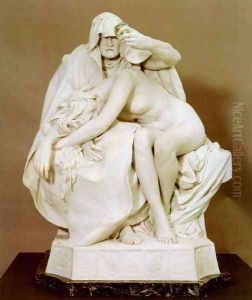Henry Alfred Pegram Paintings
Henry Alfred Pegram was a notable British sculptor whose career spanned the late 19th and early 20th centuries, a period known for its rich artistic innovation and the revival of classical forms in sculpture. Born in London in 1862, Pegram was part of an era that saw a resurgence of interest in the arts, particularly in the United Kingdom, which was undergoing significant cultural and industrial transformations. Pegram's work is often characterized by its adherence to classical themes and techniques, yet it also reflects the Victorian and Edwardian sensibilities of his time, making his sculptures distinctive for their blend of the ancient and the contemporary.
Pegram studied at the Royal Academy Schools, a prestigious institution that has nurtured many of Britain's most renowned artists. His education there provided him with a solid foundation in the principles of sculpture and the classical traditions that he would both honor and reinterpret throughout his career. Early in his career, Pegram gained recognition for his allegorical and mythological works, which were popular in the Victorian era. His sculptures often featured figures from mythology and literature, rendered with an attention to detail and an emphasis on idealized beauty that was typical of the period.
Throughout his career, Henry Pegram took on a variety of commissions, including public monuments, memorials, and architectural sculptures, demonstrating his versatility as an artist. One of his most famous works is the memorial to Queen Victoria in front of Buckingham Palace, for which he contributed sculptures representing Courage and Constancy. This commission is indicative of the high regard in which he was held and his ability to convey noble and lofty ideals through his art.
Pegram's contributions to sculpture extend beyond his individual works. He was part of a broader movement that sought to elevate sculpture as a medium of public art and national identity. His works can be found in various public spaces and galleries, offering a glimpse into the artistic and cultural values of his time. Despite the changing tastes in art and the move toward modernism in the 20th century, Pegram's sculptures have endured, appreciated for their craftsmanship and historical significance.
Henry Alfred Pegram passed away in 1937, leaving behind a legacy that has continued to be celebrated for its contribution to British sculpture. His career reflects the transitions and tensions in art between the traditional and the modern, the national and the universal. Pegram's work remains a testament to the enduring appeal of classical forms and the ability of sculpture to capture and convey the human experience across generations.


